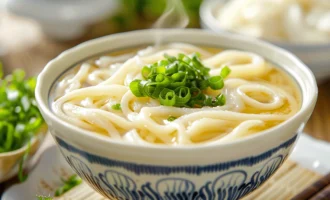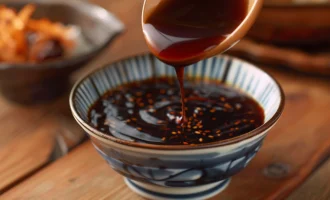Funchosa, also known as glass noodles or cellophane noodles, has its origins in Asian cuisine and has become popular worldwide for its unique texture and versatility in dishes. Made from starch, typically mung bean or sweet potato, funchosa is cherished for its ability to absorb flavors, making it an ideal candidate for pairing with a rich and flavorful sauce. The sauce for funchosa, often a blend of savory, sweet, and spicy elements, complements the neutral taste of the noodles, enhancing the overall dish. This sauce is not only a staple in noodle dishes but also serves as a vibrant dressing for salads and a dipping sauce for spring rolls and dumplings.
- Soy sauce 60 g
- Sesame oil 30 g
- Rice vinegar 30 g
- Honey 20 g
- Garlic 10 g
- Ginger 10 g
- Red chili flakes 5 g
- Lime juice 20 g
- Green onions 20 g
- Sesame seeds 5 g
- Begin by finely mincing the garlic and ginger. Juice half a lime and chop the green onions finely. These fresh ingredients will add a burst of flavor to the sauce.
- In a medium bowl, whisk together the soy sauce, sesame oil, rice vinegar, and honey until the honey is fully dissolved and the mixture is well combined.
- To the bowl, add the minced garlic, ginger, red chili flakes, and lime juice. Whisk again until everything is evenly incorporated. The garlic, ginger, and chili flakes will infuse the sauce with a vibrant flavor profile.
- Stir in the chopped green onions. Sprinkle sesame seeds over the sauce just before serving to add a nutty flavor and a slight crunch.
- Pour the sauce over cooked funchosa noodles and toss to ensure the noodles are evenly coated. Alternatively, use the sauce as a dressing for funchosa noodle salad or as a dipping sauce for appetizers.
Storage Tips
This sauce can be stored in an airtight container in the refrigerator for up to 1 week. The flavors will continue to meld and develop over time, often resulting in an even more flavorful sauce after a day or two. It’s not recommended to freeze this sauce due to the changes in texture that can occur with the sesame oil and fresh ingredients upon thawing.
Useful Properties of Soy Sauce
Soy sauce, the base of this funchosa sauce, is rich in compounds that may offer health benefits, including antioxidants and anti-inflammatory properties. It’s a good source of trace minerals like manganese and selenium, as well as protein and fiber from the soybeans it’s made from.
Interesting Facts about the Sauce
- Culinary Diversity: This type of sauce showcases the diversity of Asian cuisines, incorporating ingredients from Chinese, Korean, and Japanese cooking traditions to create a harmonious flavor.
- Historical Significance: Soy sauce, a key ingredient, has been used in Asia for thousands of years, originating in China as a way to stretch salt, an expensive commodity.
- Nutritional Synergy: The combination of ingredients in this sauce not only provides a depth of flavor but also combines nutritional benefits, such as the healthy fats from sesame oil and the vitamins found in lime juice and green onions.
This funchosa sauce recipe is a celebration of flavors, textures, and nutritional benefits, offering a delicious way to elevate simple noodle dishes into memorable meals. Whether you’re dressing a salad, tossing with noodles, or dipping, this sauce is sure to add a vibrant touch to your culinary creations.







